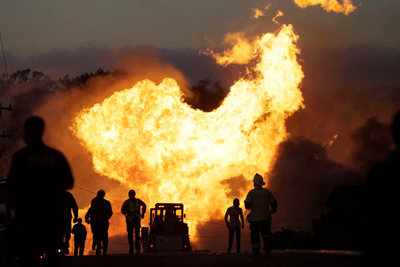
In this 2010 file photo, a massive fire roars through a mostly residential neighborhood in San Bruno, Calif. A report released Friday by the Department of Transportation's inspector general says the federal agency responsible for making sure states effectively oversee the safety of natural gas and other pipelines is falling down on the job. (AP Photo/Paul Sakuma, File)
WASHINGTON (AP) � The federal agency responsible for making sure states effectively oversee the safety of natural gas and other pipelines is failing to do its job, a government watchdog said in a report released Friday.
The federal effort is so riddled with weaknesses that it's not possible to ensure states are enforcing pipeline safety, the report by the Transportation Department's Office of Inspector General said. The federal Pipeline and Hazardous Materials Safety Administration, or PHMSA, isn't ensuring key state inspectors are properly trained, inspections are being conducted frequently enough and inspections target the most risky pipelines, it said.
The findings come more than three years after a gas pipeline explosion and fire killed eight people, injured 58 and destroyed much of a subdivision in San Bruno, California, a suburb south of San Francisco. Accident investigators cited weak state and federal oversight.
The nation's network of about 2.5 million miles of pipelines moves millions
of gallons of hazardous liquids and 55 billion cubic feet of natural
gas every day. Eighty-five percent of these pipelines are under
state authority. The report doesn't address the safety administration's
oversight of interstate pipelines like the proposed Keystone XL
oil pipeline.
Cynthia Quarterman, head of the safety administration, defended
her agency's record, pointing to a two-thirds decline in the number
of accidents and incidents involving gas distribution pipelines
over the past 30 years.
There were 21 serious incidents on distribution pipelines in
2013 and 24 incidents in 2012, "which were the lowest number of
serious incidents on record for the past 30 years," she said in
response to the inspector general's findings included in the report.
Since 2010, when the San Bruno and four other major accidents
occurred, she wrote, there have been no serious incidents to date
on intrastate transmission lines, which are larger than distribution
lines. But the agency also fully or partially agreed with seven
recommendations made in the report.
Among the weaknesses cited in the report is that the safety administration
is using an outdated formula to calculate the minimum number of
inspectors states need. More inspectors may be needed to carry
out new inspection methods and responsibilities since the formula
was developed in the 1990s.
More than 20 percent of the nation's total gas distribution pipelines
are more than 50 years old or composed of material such as cast
iron or bare steel that are more susceptible to failure than newer
pipelines made with more resilient materials. However, the safety
administration's staffing formula also doesn't take into account
whether more personnel are needed to inspect these riskier pipelines,
the report said.
The agency also hasn't set minimum qualifications for state inspectors
who lead inspection teams, the report said. In one state, for
example, an inspector with less than one year's experience was
allowed to lead inspections, it said.
"Because it has not set minimum qualifications for state inspectors
to lead standard inspections, PHMSA cannot be sure that state
inspections cover all federal requirements and ensure pipeline
operators maintain safety," Assistant Inspector General Jeffrey
Guzzetti said in the report.
The safety administration requires states to use 14 risk factors
when deciding how to prioritize pipeline inspections, but the
agency isn't explicit on how the risk factors are supposed to
be weighed, the report said.
As a result, four of five states examined by the inspector general's
office were simply scheduling inspections based on how long it
had been since the previous inspection, ignoring other risk factors,
the report said. The safety administration also doesn't tell states
how often pipelines must be inspected. Investigators found one
state was allowing as long as eight years to lapse between reviews.
"Because of these oversight gaps, PHMSA cannot be sure that states
detect and mitigate safety risks," Guzzetti wrote.
The safety administration has six evaluators who annually certify
48 state agencies and conduct in-depth reviews every three years
to ensure states are following federal guidelines, the report
said. PHMSA provides about 80 percent of the funds states spend
on pipeline safety, the report said.
JOAN LOWY / Source: Associated Press
Online:
Transportation Department Inspector General's report
| ![]()




